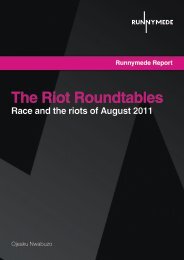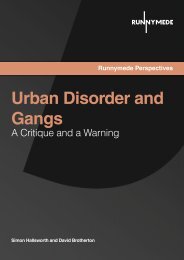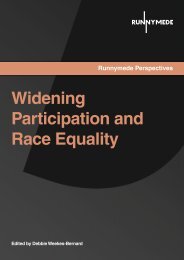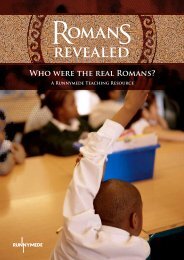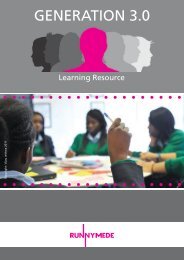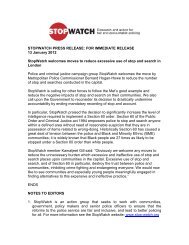PARENTINg - Runnymede Trust
PARENTINg - Runnymede Trust
PARENTINg - Runnymede Trust
Create successful ePaper yourself
Turn your PDF publications into a flip-book with our unique Google optimized e-Paper software.
REVIEWS<br />
BOOK<br />
me<br />
d<br />
n<br />
ed<br />
1990s,<br />
children,<br />
ide with<br />
r the care<br />
migrants<br />
children,<br />
n are far<br />
ild<br />
pectives,<br />
iving<br />
BN 978-92-3-104091-7<br />
789231 040917<br />
Graphic design: Pierre Finot<br />
MIGRATING ALONE<br />
Edited by: JYOTHI KANICS, DANIEL SENOVILLA HERNÁNDEZ<br />
& KRISTINA TOUZENIS<br />
MIGRATING<br />
ALONE<br />
UNACCOMPANIED AND SEPARATED<br />
CHILDREN'S MIGRATION TO EUROPE<br />
Edited by: JYOTHI KANICS,<br />
DANIEL SENOVILLA HERNÁNDEZ<br />
& KRISTINA TOUZENIS<br />
Migrating Alone:<br />
Unaccompanied and<br />
Separated Children’s<br />
Migration to Europe<br />
Edited by Jyothi Kanics, Daniel Senovilla<br />
Hernández and Kristina Touzenis<br />
UNESCO Publishing, 2010, ISBN 978-9-<br />
23104-091-7.<br />
Publication reviewed by Claudia Santoro<br />
This UNESCO publication looks at the<br />
planned, forced or spontaneous decision<br />
to abandon the household from the point<br />
of view of a young migrant, and tries<br />
to deconstruct the disparity between<br />
principles agreed by governments<br />
and the reality of individual lives whose<br />
dignity and human rights are violated.<br />
Originating from the findings of a<br />
conference organised by MIGRINTER<br />
and the International Juvenile Justice<br />
Observatory in 2007, the issue of<br />
unaccompanied minors was brought into<br />
an international forum where researchers<br />
and field practitioners shared experiences<br />
in order to map the phenomena.<br />
The conference focused on the<br />
comparison of legislation frameworks,<br />
presented the state of the situation of<br />
children who lack protection and looked<br />
at the issues connecting different angles:<br />
providing a detailed judicial review of<br />
the legal tools established to protect<br />
separated children, and analysing<br />
the complex and diverse situation in<br />
which children in Europe live. Children’s<br />
pre-migration experiences in their<br />
countries of origin were also considered,<br />
offering detailed regional focuses<br />
constructed through extremely accurate<br />
and innovative field research, therefore<br />
providing the scientific background which<br />
is necessary to detail the phenomena<br />
and build social policies.<br />
The first section looks at the situation of<br />
unaccompanied children in European<br />
countries, where the issue is evolving in<br />
different ways and requires harmonisation<br />
policies and EU intervention. Indeed, even<br />
in countries where a protection system<br />
exists, these practices rarely grant minors<br />
the treatment they are entitled to and their<br />
rights too often get lost in the machinery<br />
of countries’ bureaucracy systems or in<br />
forced return policies.<br />
The authors have attempted to shape a<br />
paradigm in which children are placed<br />
in mainstream facilities, but with their<br />
integration monitored and every single<br />
case analysed separately. This is<br />
because unaccompanied minors are<br />
not only children and migrants, but also<br />
potential victims of sexual abuse and<br />
other forms of exploitation.<br />
The book extensively clarifies the role<br />
of the guardian: a figure established to<br />
ensure that the rights of every single child<br />
are represented. It shows that although<br />
detailed legislative guidance states that<br />
the legal protection must be additional to<br />
the appointment of the guardian, in over<br />
half of the states analysed this person is<br />
merely a legal representative, rather that<br />
someone who should ensure children’s<br />
physical and physiological well-being.<br />
Migrating Alone also investigates the<br />
reasons that young migrants move:<br />
starting from a solid research-based<br />
background that links up young migrants<br />
from Albania, Morocco and Romania<br />
with targeted EU settings, authors draw<br />
trajectories built of transnational media,<br />
criminal trafficking and marginalisation.<br />
The desire to support families emerges<br />
as one of the major reasons explaining<br />
migration, but there are also children who<br />
leave their home voluntarily, escaping<br />
violence perpetrated by members of their<br />
own families.<br />
The situation of young migrants, both in<br />
the host and origin country, suggests the<br />
necessity to deconstruct the paradigm of<br />
minors’ victimisation is an indispensable<br />
step of social intervention, seen as the<br />
unique way to focus on needs and priorities.<br />
Moreover the comparative approach<br />
connects reasons for leaving with diverse<br />
experiences in the host countries,<br />
providing a context that presents the<br />
challenges of the reception, which apart<br />
from being driven by a re-educational<br />
priority, needs to build new possibilities.<br />
The book contains other relevant<br />
contributions, including a significant<br />
explanation that draws highways of<br />
migration, risks and vulnerability and<br />
links the North and South of the world.<br />
The book makes the point that considering<br />
unaccompanied children merely as<br />
migrants rather than children decreases<br />
the possibility of their being protected,<br />
as the international standards protecting<br />
migrants are much weaker that those<br />
established to ensure children’s rights.<br />
The conclusion is left to the Council of<br />
Europe Commissioner for Human Rights<br />
who summarises the findings of this<br />
study and warns that data collection<br />
on unaccompanied minors lacks<br />
homogeneity, accuracy and regularity,<br />
and that a mapping process is therefore<br />
needed .<br />
Separated minors need life projects<br />
taking into account the multiple<br />
discriminations they face, and those<br />
projects need the commitment of<br />
states, formal training and a structured<br />
monitoring process. As Commissioner<br />
Hammarberg concludes: “Europe<br />
cannot fail with young newcomers”. It is<br />
necessary to remember that whether they<br />
migrate to escape violence or improve<br />
their condition, separated children are<br />
‘future-seekers’ and the first step for<br />
their harmonic integration into society<br />
is remembering they also have human<br />
rights.<br />
30 | RUNNYMEDE BULLETIN | Autumn 2011 / issue 367 www.runnymedetrust.org



